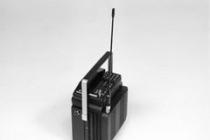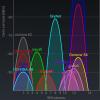Hello comrade friends!
Uncle doctor - it will be me!
My robe is in the suitcase
Stethoscope always in your pocket,
We'll take the head on occasion.
It is difficult to imagine a modern doctor without a listening instrument hanging around the neck of a stone, sometimes called "ears", then a "pipe", or something else. In my undergraduate student song (see epigraph), this instrument is called a stethoscope. Let's try to figure out what it is and why it is needed.
Doctors are such, contagious, meticulous. They need to know everything about the patient. It is not enough for them to take the soul out of him, to ask about all the little things in his life and his relatives up to the ninth generation. They want an objective reality, which is given to us in sensations. For example, to touch the patient, especially if it is a young sympathetic patient, covered with a blush from the touch of the doctor's cold shaking hands. Or knock on it. No, not with a hammer, although this is also interesting - the legs twitch so cool, but the toes. Or listen to what kind of sounds are heard in the patient's inner world. The first method of examination is called "palpation", the second - "percussion", the third - "auscultation".
We will talk about auscultation today. Her opportunities are very broad. You can, for example, hear the incipient pneumonia and precisely establish its localization. Or determine the caliber of the bronchi affected by bronchitis. Or hear a heart murmur characteristic of a particular defect. Or to detect - the intestine is "standing" after an abdominal operation or has already "started". There are plenty of opportunities.
Knock speed
However, it will not be possible to do without a story about percussion altogether. At least in order to maintain continuity. And remember one doctor, whose name was somehow lost in the wilds of history. Undeserved. It is about the Viennese physician Leopold Auenbrugger (1722-1809), the author of the percussion method.
As the son of an innkeeper, Leopold often watched his father determine the amount of wine in the kegs by tapping the walls. It is possible that it was these observations that led him to the idea of using percussion to determine the presence of fluid in the chest cavity.
For 7 years, Auenbrugger studied sounds made when tapping the chest in healthy and sick people. He systematically correlated his clinical observations with autopsy data. This is how the 95-page work appeared in 1761 "A new discovery that allows, on the basis of the data of percussion of the human chest, as a sign, to detect hidden in the depth of chest diseases" (Inventum novum ex percussionae thoracis humani ut signo abstrusos interni pectoris morbos detegendi).
Today we know that tapping is cool and informative, but then percussion was greeted with derision at best, and openly hostile at worst. Vienna doctors and their patients, who only felt their pulse, condemned the "long and painful procedure." But in order to carry it out, it was also necessary to undress the patients. And the patients too. Moreover, the method was not recognized by Auenbrugger's teacher, rector of the University of Vienna, founder of the Vienna clinical school Gerard van Swieten (1700-1772). Leopold had to leave the university and leave his practice in a Spanish hospital in Vienna. The great doctor ended his years in a madhouse, where he died in 1809.
Nevertheless, the falling banner of the new method was picked up in France, and not just anyone, but the founder of national clinical medicine, the physician of Napoleon I, Jean Nicolas Corvisard de Mare (1755-1821). Korvizar learned about percussion by chance, from a small work by the Viennese physician Maximilian Stoll (1742-1787), who used this method in a small hospital for the poor on the outskirts of Vienna. “I don’t remember even once, during the entire time I studied medicine, that the name of Auenbrugger was mentioned. I did not know percussion when I started teaching clinical medicine,” Corvizar wrote.
He developed and refined Auenbrugger's method, translated it into French and thoroughly supplemented Inventum novum, publishing a 400-page work.
Listen to me, Banderlog!
Not to say that the idea of tapping or listening to a patient was super revolutionary. It is believed that they were known back in the time of Hippocrates, only they were used rather limitedly, for example, they tapped out only the liquid in the abdomen (ascites). And the method of listening had one, but a serious technological flaw - the doctor had to apply his ear to the patient's chest. And in this form, the method of auscultation, or rather, direct auscultation, was taught to many generations of doctors. It was also taught by Jean Corvizard, who lectured in the amphitheater of the Charité hospital. The young Rene Theophilus Hyacinth Laennek (1782-1826), who was to make such a small revolution in medicine, also listened to these lectures.
By the way, there were all the prerequisites for this. René was brought up in the family of his uncle, a famous physician during the French Revolution. Studying Greek and Latin, Laennec read in his youth the works of ancient Greek and Roman authors in the original. During his student years, Jean Corvisard had a huge influence on him.
While still a student at the University of Paris, Laennec became interested in consumption (tuberculosis), which at that time mowed down the population no worse than the plague. Rene tried to find a method for early diagnosis, because when the patient began to cough up blood, nothing could be done. There was still a lot of time left before Roentgen rays discovered his name (1895), direct auscultation did not give any tangible results, and it was problematic to attach the ear to each patient. Sometimes banal lice interfered, sometimes - a young age and belonging to the female sex (especially in combination with a noble origin), sometimes - an excessive layer of subcutaneous fat.
An apple fell on Newton, Mendeleev dreamed of a table, and Laennek was helped by children. Returning from the clinic through the Louvre park, he drew on a band of children frolicking around the logs of a scaffold. Some children put their ear to one end of the log, while others enthusiastically beat the other end with a stick. The sound, passing through the tree, was amplified.
The opportunity to test my guess in practice also turned up quickly. He was summoned to a 19-year-old plump lady who needed to listen to her heart. How to do it? Deushka is full, the heart is shitty - after all, with direct auscultation, the heartbeat was listened to mainly from the back, not to climb between the breasts;) Then Laennek asked for several sheets of paper, rolled them into a tight tube, put one end of the tube to the girl's chest, and the second to your ear.
“I was equally surprised and satisfied when I heard heartbeats so clear and distinct that I had never heard them even when the ear was directly applied to the region of the heart,” Laennec later admitted. Thus, the method of mediocre (or mediated) auscultation was born, which made a revolution in diagnosis.
Evolution of the stethoscope
Laennek called the invented device a "stethoscope" (stethos - chest, skopeo - to look, explore, Greek). At first, he glued them from thick paper, then began to experiment with different types of wood. His own stethoscope was very different from what we are used to seeing today. It consisted of two wooden parts that could be connected together or used separately, depending on specific purposes.
With the help of a stethoscope, Laennek was able to carry out his research on pathological anatomy, clinic and diagnosis of lung diseases with maximum efficiency, which, in fact, constitutes his main contribution to medicine. In addition, he described the auscultatory signs of heart defects, studied the clinic and pathomorphology of portal cirrhosis of the liver, which to this day is called Laenneck's cirrhosis, established the specificity of the tuberculous process, described the formation of "tubercles", by which he gave a new name to consumption. Long before Robert Koch's work, Laenneck considered tuberculosis to be a contagious disease, and offered increased nutrition, rest and sea air as a treatment in the early stages.
Laennek's most famous work came out in 1819. It was called traditionally long and floridly: "About mediocre auscultation or recognition of diseases of the lungs and heart, based mainly on this new research method"... Seven years later, Rene Laennec died of tuberculosis. He was overtaken by a disease, for the study of which he, perhaps, did more than anyone else.
Not to say that a cloudless future awaits the stethoscope. Many doctors did not take it, for example, in the USA. The founder of the American Heart Association, Professor Connor, until the end of the 19th century, preferred to press his ear against a silk scarf draped over the patient's chest.
However, the method and tool began to gain popularity. They began to develop and improve. This is how the familiar wooden stethoscopes with sockets appeared, which increased the area of contact with the patient's skin and the doctor's ear.
Later, pipes were attached to the wooden (or ebonite) parts, which were inserted into the doctor's ears:
The tubes were not only metal, but also rubber:
The pursuit of the "right" sound sometimes led to very unusual results. Such, for example, as Alison's "differential stethoscope". It was believed that two separate heads should create a stereo effect. In fact, such a tool turned out to be very difficult to use:
In 1894, the first phonendoscope appeared. It differed from a stethoscope by a membrane that covered the entire working surface. She improved the conduction of sound, it became possible to hear more nuances:
Later "ears" began to be made with two heads, one of which was a flat and closed membrane, and the second was made in the form of an open cone. However, there were "budget" options with one head and a removable membrane. The two-in-one combination is officially called a stethophonendoscope, but I have never heard this term in the medical environment;)
The stethoscope in the Rappaport-Sprague modification took on a completely familiar look in the 40s of the XX century. A classic rappaport performed by, by the way, Hewlett-Packard looks like this:
In the 60s, a modification of Harvard University professor David Litman appeared, lighter and more compact than bulky rapports:
By the way, classic wooden stethoscopes are still used in some places. They are especially loved by old-school obstetricians and gynecologists to listen to the fetal heartbeat.
Now it's come down to computer systems, called stethophones - there it comes down to the analysis of sound and the issuance of a preliminary diagnosis. However, the ears of an experienced doctor cannot be replaced by anything.
My first "pipe" was a classic Polish-made litman, inherited from my father. A " workhorse"there is still a Japanese rappaport with a bunch of baits.
A stethoscope is a medical device with which it becomes possible to conduct auscultation, that is, to listen to sounds that are present in the heart, blood vessels, lungs, intestines, bronchi and other internal organs of a person. The most famous fields of application this appliance are listening to Korotkoff tones in the process of measuring blood pressure, as well as determining the location of the probe inside the stomach during its lavage or enteral nutrition.
The head, which must be applied to the surface of the human body in the place necessary for listening and which has the ability to capture various sounds in the organs, serves as a working part of the stethoscope. Other parts of the device are flexible sound-conducting tubes, through which sound enters the specialist's auditory canals for analysis.
There are also non-medical models of stethoscopes, the purpose of which lies in the technical diagnostics of the functioning of various mechanisms - the crank mechanism, bushings, assemblies and parts. In a technical stethoscope, the sensitivity of the device is given by a thin metal rod, which is leaned against the research site.
History of origin
Back in 1816, the French physician Rene Laennec, who is the progenitor of the diagnostic auscultation technique and the entire scientific diagnostic method, invented the first stethoscope. In those days, to listen to the internal organs of patients, it was customary to put the ear to their body, which the innovative doctor categorically did not want to do, therefore he used rolled paper for this purpose, which perfectly conducted the sound, making it even clearer than with direct listening using attaching the ear. Since that time, the stethoscope has been modified and improved, but the principle of its operation and physical characteristics have remained the same.
In 1894, the improved stethoscope was proposed to be called a phonendoscope by the professors of physics and preparatory clinical medicine A. Byanshi and G. Bazzi. The stethoscope acquired its modern form in the 1940s, when it was improved by Sprague and Rappaport, creating a new example of the standard for this device. Today it is called in the scientific community - the Sprague-Rappaport stethoscope.
A modern device called a stethoscope has helped to combine a stethoscope funnel and a phonendoscopic membrane in the design of a bilateral head. The term "stethoscope" today means both a phonendoscope and a stethoscope.
Stethoscopes design
 The design of a modern stethoscope is necessarily present:
The design of a modern stethoscope is necessarily present:
- head;
- membrane and funnel;
- sound line;
- temples;
- olives.
The head of the stethoscope is the part that must be applied directly to the patient's body in order to capture and amplify auscultatory sounds inside the organ being examined. Heads can be double or single sided. On one-sided heads, either funnels or membranes are located (in most cases). On bilateral, on both sides of the head, there are both, or on both sides of the head, membranes of different diameters are located. With double-sided heads, to switch them, it is enough to turn the fitting 180 degrees, which is structurally connected to the sound line.
For capturing high-frequency auscultatory sounds, it is more rational to use a membrane, which is more sensitive in this case, and a funnel is better for low-frequency sounds. A membrane is understood to be flat or slightly convex outward, by analogy with glass wrist watch, plate mounted on the head of the stethoscope. It can usually be easily changed over time or as needed. Glass fiber reinforced epoxy membranes are ultrasensitive, while PVC membranes are less sensitive.
The sound guide is a flexible elastic hose with the help of which the sound is conducted from the head of the device to the hearing aid (in other words, the ears) of the specialist. Sometimes the head is connected to one, and sometimes to two sound lines. But even in the case of a single sound line in front of the arches, it must be divided into 2 parts.
The arms of a stethoscope are a pair of metal tubes that connect to a sound line. The springs of the temples ensure a tight fit of the olives to the auricles. The earpieces can be positioned forward so that the earpieces can be inserted into the ears at an angle to the ear canals.
And, finally, olives are two rounded attachments on the arms of a hard or soft texture, which provide a comfortable fit of the stethoscope in the external auditory canal of the specialist performing the examination with the device. Olives differ in size, they must be individually selected in accordance with the size of their own auditory canals. Olives, as well as membranes, can be easily replaced in the structure of this device with new or more comfortable ones. Ideally, the olives will fit comfortably over the investigator's ears without pressing too hard or falling out of them. Thus, the closedness of the sound system is ensured, which avoids the creation of an empty space between the olive and the ear and provides high quality auscultation.
Varieties of the device
A stethoscope can be subdivided in medical practice according to the categories of patients for whom it is used in the practice of doctors. Thus, a therapeutic stethoscope is intended for listening to adult patients, a neonatal one - for newborn babies under the age of 28 days, and a pediatric one is used for auscultation of pediatric patients. The last 2 types of the device differ from the therapeutic device in the smaller size of the listening head.
In the practice of doctors, the Rappaport stethoscope is widely used, which is distinguished by its versatility for patients of any age. Its distinctive feature is a massive double-sided head, on which it is possible to install different nozzles - 3 types of funnels and 2 types of membranes, as well as being equipped with two independent sound lines to ensure the quality of sound transmission. The only drawback of this device is its heavy weight.
Also, stethoscopes are divided into types, depending on the specifics of the specialist's work. Cardiac stethoscopes are characterized by increased acoustic performance, which provides a much wider sound spectrum when listening to heart sounds. The Pinara fetoscope or stethoscope is used in gynecology to listen to fetal heart sounds during pregnancy. It is most similar in design to the first devices that were invented 2 centuries ago. It is a stethoscope in the form of a rigid tube with a two-ended bell. When measuring blood pressure in patients, a simple device is used, equipped with a single head with a membrane.
In modern medical practice, an electronic stethoscope is widely used today, which contains a microphone in its own head, which is capable of converting the sounds perceived by the device into an electronic signal to be processed and output to the speakers, which are built into the device's olive. It can be used to perform auscultation with double conversion of the received sound in the adult category of patients.
One of the most important aspects of the development of cardiology and the diagnosis of cardiovascular diseases was the creation of a stethoscope. This invention made it possible to obtain a reliable and high-quality tool for determining the state of various internal organs, and for prompt diagnosis without interfering with the work of the body. Its creator laid the foundation for a unique diagnostic technique of auscultation, which has many advantages, as a result of which it is actively and effectively used today.
Inventor story
The inventor of the stethoscope was Rene Laennec, a hereditary French doctor and researcher who was actively involved in diagnostics and the study of the peculiarities of the work of internal organs. He was born in 1781 and raised by his relative, a famous doctor, who from childhood instilled in him a love of science and taught him many of the intricacies of the profession. Even in his youth, during his studies, Laennek showed very good results, and despite his very peculiar character, he easily achieved respect among eminent teachers.
After studying and starting practice, he entered the service as a surgeon, where he was able to visually demonstrate and hone his skills. In this regard, after the service, he was invited to work in one of the leading Parisian clinics, in which he worked under the supervision of Napoleon's own physician, Corvizar. There, he actively took up scientific work, published several interesting articles and began to specialize in the study of the work of the heart muscle, starting with the works of Hippocrates, who first described the structure and features of this organ, and ending with the knowledge of his contemporaries, as well as diagnostic technologies such as applying the palm and percussion. ... In France at that time, using these methods, doctors determined the characteristics of the heart and could quickly diagnose.
Brilliant idea
Once in his practice, an interesting incident occurred, which served as the reason for the creation of a unique device, and subsequently a fundamentally new diagnostic method. Laennek was invited to an examination by a famous lady who was experiencing pain in the chest area, but upon arriving to her, he found that, due to her excess weight and large body fat, the standard methods simply did not work on her.
After some reflection, he recalled an interesting fun that he had learned in childhood - if you lean your ear to one side of a large log, and from the other end it is easy to tap on it with a needle, the sound will be heard very clearly. Then the doctor rolled up the magazine, put one end of it against his chest, and put his ear to the other. Thus, he was able to very clearly hear all the features of the heartbeat, and the quality of the sound led him to the idea that this method could also be used in the study of other organs.
After this incident, he set out to create a prototype on his own, tried many different options, and in the end chose walnut, from which he carved a hollow cylinder. This is what he called "Le Cylindre" his own invention, which immediately showed amazing results. Using his device, he was able to fully describe the clinical picture, and offered the most effective method treatment.
Development of invention
It took him about a year to carry out the necessary research on various patients. Then, in 1818, he presented his discovery to the French medical community, and gave a talk on a new technique for indirect auxultation. At the same time, he spoke in more detail about heart diseases that he was able to identify using a stethoscope, the name of which he had already changed by that time. Another of his outstanding achievements, which he presented to colleagues, is the description of the features of pulmonary tuberculosis. He paid a lot of attention to this disease, and provided effective methods for the treatment of this disease.
Laenek's further career was strongly associated with the use of a stethoscope to determine the characteristics of a particular disease. In his scientific research, he published a mass interesting information about the features of a whole list of diseases of the lungs, heart and other internal organs. However, other doctors began to use the stethoscope with great interest, thanks to which this invention, and with it the whole new technology diagnostics has become really popular and effective in just a couple of decades.
Over time, after the death of the author, who died of tuberculosis, some changes were made to the design of the device, and it was modified to a device called a phonendoscope, which has a specialized membrane that makes it even easier to hear the features of the work of various internal organs and even measure blood pressure.
The phonendoscope has now become one of the most important and irreplaceable tools in the work of almost every doctor, and most of the necessary important information specialists learn about the patient by using it. The discovery of the stethoscope opened a whole new chapter in the field of diagnosis, and allowed medicine to take a huge leap forward.
Scientists from Ben Gurion University Located in Israel on YouTube, the headphones can be easily modified to function as recording microphones. The secret of this transformation lies in the ordinary physics that is taught in high school. So the speakers in the headphones convert electromagnetic signals into sound waves through the vibration of a special sensitive membrane. But these membranes can also work in the opposite direction, that is, receive sound vibrations and convert them into electromagnetic signals.
In one of the videos posted on Vice News, Snowden demonstrated how you can protect yourself from eavesdropping by removing the internal microphone from a regular smartphone. In addition, the iFixit website also demonstrated in its video how to mute the microphone on MacBook Pro laptops.
JavaScript is disabled in your browser
As Mordechai Guri noted, this problem is very serious, because even after removing the microphone from the computer, the user's conversations can still be recorded through the headphones. At the moment, the vulnerability affects Realtek chips, which means it cannot be fixed with a software patch. The only way to avoid attacks is to upgrade your hardware or stop using headphones.
In fact, everything described above is a long-known common truth, since the process of wiretapping has long been studied and received the name " microphone effect ".
As the encyclopedia describes, " microphone effect " is an undesirable phenomenon in which some part of the electrical circuit perceives sound vibrations and vibrations like a microphone. Most often it occurs when the capacitance changes, especially in high-frequency circuits, where even minor vibrations of poorly fixed parts can significantly affect the parameters of the main signal.
Anatoly Torokin in his book Engineering and Technical Information Security, describes the physics of the process: " Acoustoelectric transducers include physical devices, elements, parts and materials that are capable of creating equivalent electrical signals under the action of an alternating pressure of an acoustic wave. The properties of acoustoelectric transducers are used for their functional purpose to create microphones different types... But there are various radio-electronic and electrical elements and devices that have the so-called "microphone effect", that is, they are capable of converting acoustic signals into electrical ones. This leads to the appearance in these radios and electrical devices dangerous signals that create prerequisites for information leakage. "
Stethoscope (from the Greek stethos - chest and skopeo - looking, exploring)
a device for listening to heart sounds, breathing sounds, and other natural sounds that occur in the body of humans and animals. It was invented in 1816 by the French physician R. Laennec (1781-1826), the founder of the diagnostic method of auscultation (see Auscultation). Simple (solid) seals have the shape of a tube made of wood, ebonite, etc. with funnels of different diameters at the ends. Their advantage is the transmission of sound not only through the air column, but also through the hard part of the S. and the temporal bone of the examiner. More common are binaural (soft) S., consisting of a funnel and elastic tubes, the ends of which are inserted into the external auditory canal, they are more convenient when examining a patient, they are often combined in one device with sound-amplifying Phonendoscope amy .
Big Soviet encyclopedia... - M .: Soviet encyclopedia. 1969-1978 .
Synonyms:See what "Stethoscope" is in other dictionaries:
Stethoscope ... Spelling dictionary-reference
- (Greek, from stethos chest, and look skopeo). A medical device consisting of a tube, funnel-shaped widened at one end, and having a somewhat convex round ivory plate at the other, serving to listen to the patient for ... ... Dictionary of foreign words of the Russian language
- [stethoscope], stethoscope, man. (from the Greek stethos chest and skopeo I observe) (honey). A tube for listening to heart and lung sounds. Rubber stethoscope. Metal stethoscope. Stethoscope. Ushakov's explanatory dictionary. D.N. Ushakov. 1935 ... ... Ushakov's Explanatory Dictionary
stethoscope- a, m. stéthoscope m., German. Stethoskop c. stethos chest + scopeo look. 1. A medical instrument in the form of a tube for listening to the heart and lungs. ALS 1. On the real benefits of examining the breast with a stethoscope. 1848. PSZ 2 23 (1 ... ... Historical Dictionary of Russian Gallicisms
Tube, phonendoscope Dictionary of Russian synonyms. stethoscope n., number of synonyms: 3 earpiece (3) ... Synonym dictionary
- (from the Greek stethos chest and ... osprey), a tube for auscultation (listening) of the lungs, heart, blood vessels (for example, when measuring blood pressure) and other organs. In modern medical practice, a phonendoscope is often used, consisting of ... ... Modern encyclopedia
- (from the Greek stethos chest and ... osprey) a wooden or plastic tube for auscultation of the lungs, heart, blood vessels (for example, when measuring blood pressure) and other organs. In modern medical practice, a phonendoscope is often used, ... ... Big Encyclopedic Dictionary
STETOSCOPE, a tool for researching and listening to the activities of different parts of the human body, mainly the heart and lungs, and assessing their condition. It includes two earpieces connected by flexible rubber tubes with ... ... Scientific and technical encyclopedic dictionary
STETHOSCOPE, ah, husband. (specialist.). Wooden or plastic tube for listening to the heart, blood vessels, lungs. | adj. stethoscope, oh, oh. Ozhegov's Explanatory Dictionary. S.I. Ozhegov, N.Yu. Shvedova. 1949 1992 ... Ozhegov's Explanatory Dictionary
Husband., Greek. auditory tube, listener; Doctors listen to them for breathing and heartbeat, recognizing the state of internalities by ear. Dahl's Explanatory Dictionary. IN AND. Dahl. 1863 1866 ... Dahl's Explanatory Dictionary
- (Stethoscope) apparatus consisting of a mouthpiece and headphones connected to the negotiating pipes (s). Serves to more easily capture the transmitted sounds and reduce the possibility of extraneous noise getting into the communication pipes. See ... ... Marine Dictionary
Books
- French experiments "Stethoscope" (Science with Buki) (2590 BB / EK-JD016),. Find out what a stethoscope is, get to know how it works and assemble a stethoscope yourself. Conduct a serious scientific experiment with the participation of friends and family. Composition: polymer ...














